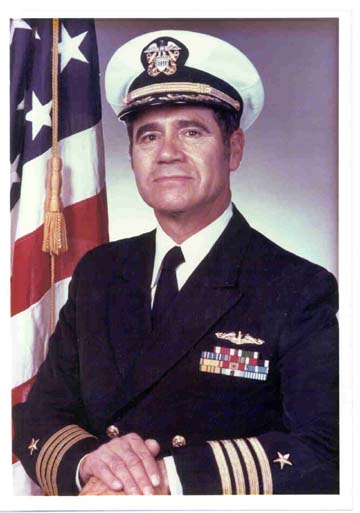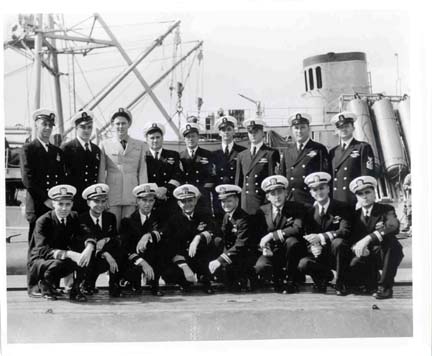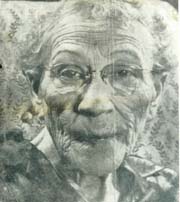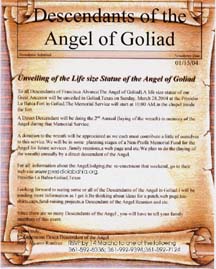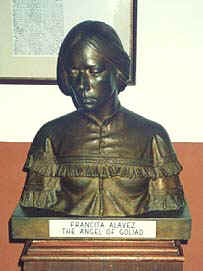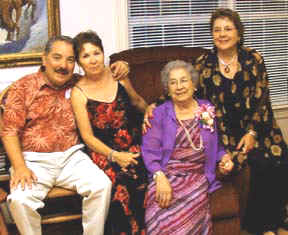Generation No. 1
1. SERGEANT MAJOR NICOLAS3 GUAJARDO (LORENZO2 MARTINEZ-GUAJARDO-NAVARRO, JUAN-FRANCISCO1 MARTINEZ-GUAJARDO) was born in Saltillo, Coahuila, Mexico. He married (1) MICAELA GUERRA-CANAMAR-MORALES, daughter of VICENTE GUERRA-CANAMAR-VELA and LEONOR DE MORALES. She was born in Saltillo, Coahuila, Mexico. He married (2) ISABEL MENDEZ-TOVAR August 01, 1689 in Saltillo, Coahulia, Mexico, daughter of JOSEPH MENDEZ-DE-TOVAR and LEONOR GUTIERREZ-HIDALGO. She was born Abt. 1671 in Saltillo, Coahuila, Mexico.
Notes for SERGEANT MAJOR NICOLAS GUAJARDO:
Source:Origen de los Fundadores de Texas, Nuevo Mexico, Coagulia y Nuevo Leon, Saltillo Tomo II
by Guillermo Garmendia Leal. Page 104.
Marriage Notes for NICOLAS GUAJARDO and ISABEL MENDEZ-TOVAR:
Marriage source:Index to the Marriage Investigations of the Diocese of Guadalajara by Raul J. Guerra, Jr., Nadine M. Vasquez, Baldomero Vela, Jr. Page 159.
Children of NICOLAS GUAJARDO and MICAELA GUERRA-CANAMAR-MORALES are:
i. NICOLAS4 GUAJARDO-GUERRA.
ii. JOSEPH GUAJARDO-GUERRA.
2. iii. ANA-MARIA GUAJARDO-GUERRA.
3. iv. JUAN GUAJARDO-GUERRA, b. Saltillo, Coahuila, Mexico.
v. ANTONIO GUAJARDO-GUERRA.
4. vi. SERGEANT MAJOR PEDRO-MARIA MARTINEZ-GUAJARDO, b. 1677; d. January 02, 1719/20, Monterrey, Nuevo Leon, Mexico.
5. vii. RAMONA-ALDONZA MARTINEZ-GUAJARDO-GUERRA, b. 1687.
Child of NICOLAS GUAJARDO and ISABEL MENDEZ-TOVAR is:
viii. JOSEPH-MIGUEL4 GUAJARDO-MENDEZ, b. February 16, 1709/10, Sagrario Metropolitano, Saltillo, Coahulia, Mexico.
Generation No. 2
2. ANA-MARIA4 GUAJARDO-GUERRA (NICOLAS3 GUAJARDO, LORENZO2 MARTINEZ-GUAJARDO-NAVARRO, JUAN-FRANCISCO1 MARTINEZ-GUAJARDO) She married (1) JUAN FERNANDEZ. She married (2) JUAN DE NORIEGA February 19, 1725/26 in Saltillo, Coahuila, Mexico. He was born in Durango, Mexico.
Child of ANA-MARIA GUAJARDO-GUERRA and JUAN FERNANDEZ is:
6. i. NICOLAS THORIVIO5 FERNANDEZ-DE-CASAFERNIZA.
3. JUAN4 GUAJARDO-GUERRA (NICOLAS3 GUAJARDO, LORENZO2 MARTINEZ-GUAJARDO-NAVARRO, JUAN-FRANCISCO1 MARTINEZ-GUAJARDO) was born in Saltillo, Coahuila, Mexico. He married (1) PETRONILA BADELLO. He met (2) MARIA-ROSA FLORES-DE-VALDEZ, daughter of JUAN FLORES-DE-VALDEZ and TERESA COLCHADA. She was born in Saltillo, Coahuila, Mexico.
Children of JUAN GUAJARDO-GUERRA and PETRONILA BADELLO are:
7. i. JUAN-ANTONIO5 GUAJARDO-BADELLO, b. Saltillo, Coahulia, Mexico.
8. ii. NICOLASA-ROSALIA GUAJARDO-BADELLO, b. 1705, Saltillo, Coahuila, Mexico.
Children of JUAN GUAJARDO-GUERRA and MARIA-ROSA FLORES-DE-VALDEZ are:
iii. ANTONIA-JOSEFA5 FLORES-DE-VALDEZ, m. JOSEPH-ANDRES DE SAN-MIGUEL, March 21, 1721/22, Saltillo, Coahulia, Mexico.
iv. JUAN ANTONIO FLORES-DE-VALDEZ, b. 1680, Saltillo, Coahuila, Mexico; m. MARIA ANTONIA DE SAN-MIGUEL, August 10, 1712, Saltillo, Coahulia, Mexico; b. Saltillo, Coahuila, Mexico.
Marriage Notes for JUAN FLORES-DE-VALDEZ and MARIA DE SAN-MIGUEL:
Source:Index to the Marriage Investigations of the Diocese of Guadalajara by Raul J. Guerra, Jr., Nadine M. Vasquez, Valdomero Vela, Jr. Page 222.
4. SERGEANT MAJOR PEDRO-MARIA4 MARTINEZ-GUAJARDO (NICOLAS3 GUAJARDO, LORENZO2 MARTINEZ-GUAJARDO-NAVARRO, JUAN-FRANCISCO1 MARTINEZ-GUAJARDO) was born 1677, and died January 02, 1719/20 in Monterrey, Nuevo Leon, Mexico. He married MARIA BAEZ-DE-TREVINO October 06, 1697 in Sagrario Metropolitano, Monterrey, Nuevo Leon, Mexico, daughter of FRANCISCO BAEZ-DE-TREVINO and CATALINA DE AMAYA-Y-TREVINO. She was born 1680, and died May 07, 1759 in Monterrey, Nuevo Leon, Mexico.
Notes for MARIA BAEZ-DE-TREVINO:
A,K,A, Maria de Amaya y Trevino.
Marriage Notes for PEDRO-MARIA MARTINEZ-GUAJARDO and MARIA BAEZ-DE-TREVINO:
Marriage source:Index to the Marriage Investigations of the Diocese of Guadalajara by Raul J. Guerra, Jr., Nadine M. Vasquez, Baldomero Vela, Jr. Page 189.
Children of PEDRO-MARIA MARTINEZ-GUAJARDO and MARIA BAEZ-DE-TREVINO are:
i. FRANCISCO JAVIER5 GUAJARDO-TREVINO, b. March 15, 1701/02, Sagrario Metro, Monterrey, Nuevo Leon, Mexico.
ii. FRANCISCO XAVIER GUAJARDO-TREVINO, b. November 02, 1702.
9. iii. GENERAL DOMINGO-MIGUEL GUAJARDO-TREVINO, b. March 16, 1703/04, Sagrario Metro, Monterrey, Nuevo Leon, Mexico; d. May 10, 1759, Monterrey, Nuevo Leon, Mexico.
10. iv. CAPTAIN PEDRO-PABLO-JOAQUIN MARTINEZ-GUAJARDO-TREVINO, b. July 16, 1708, Sagrario Metro, Monterrey, Nuevo Leon, Mexico; d. March 21, 1759, Monterrey, Nuevo Leon, Mexico.
5. RAMONA-ALDONZA4 MARTINEZ-GUAJARDO-GUERRA (NICOLAS3 GUAJARDO, LORENZO2 MARTINEZ-GUAJARDO-NAVARRO, JUAN-FRANCISCO1 MARTINEZ-GUAJARDO) was born 1687. She married JOSEPH-ANTONIO DE ECAY-Y-MUZQUIZ-Y-URRUTIA, son of ANTONIO DE ECAY-Y-MUZQUIZ-Y-URRUTIA and VICENTA VERA. He was born Abt. 1685 in Monclova, Coahulia, Mexico, and died 1738 in San Juan Bautista, Coahuila, Mexico.
Notes for JOSEPH-ANTONIO DE ECAY-Y-MUZQUIZ-Y-URRUTIA:
In 1708 - 1712, he served as Governor of Coahuila.
Source: The Handbook on Texas Online.
Child of RAMONA-ALDONZA MARTINEZ-GUAJARDO-GUERRA and JOSEPH-ANTONIO DE ECAY-Y-MUZQUIZ-Y-URRUTIA is:
i. JOSEPH MIGUEL5 DE ECAY-Y-MUZQUIZ-Y-MARTINEZ, b. June 03, 1698, Santiago Apostol, Monclova, Coahulia, Mexico.
Generation No. 3
6. NICOLAS THORIVIO5 FERNANDEZ-DE-CASAFERNIZA (ANA-MARIA4 GUAJARDO-GUERRA, NICOLAS3 GUAJARDO, LORENZO2 MARTINEZ-GUAJARDO-NAVARRO, JUAN-FRANCISCO1 MARTINEZ-GUAJARDO) He married GERTRUDIS LOBO-GUERRERO.
Child of NICOLAS FERNANDEZ-DE-CASAFERNIZA and GERTRUDIS LOBO-GUERRERO is:
i. MARIA JOSEFA6 FERNANDEZ-DE-CASAFERNIZA, m. JOSEPH GONZALEZ-VALDEZ, February 21, 1766, Saltillo, Coahulia, Mexico; b. Saltillo, Coahuila, Mexico.
Marriage Notes for MARIA FERNANDEZ-DE-CASAFERNIZA and JOSEPH GONZALEZ-VALDEZ:
Marriage source:Index to the Marriage Investigations of the Diocese of Guadalajara by Raul J. Guerra, Jr., Nadine M. Vasquez, Baldomero Vela, Jr. 1751-1779 Page 116.
7. JUAN-ANTONIO5 GUAJARDO-BADELLO (JUAN4 GUAJARDO-GUERRA, NICOLAS3 GUAJARDO, LORENZO2 MARTINEZ-GUAJARDO-NAVARRO, JUAN-FRANCISCO1 MARTINEZ-GUAJARDO) was born in Saltillo, Coahulia, Mexico. He married MARIA-LUCIA DE CUELLAR-GARCIA January 29, 1723/24 in Saltillo, Coahulia, Mexico, daughter of ASCENCIO CUELLAR-GUAJARDO and ANA GARCIA-TREVINO. She was born in Saltillo, Coahulia, Mexico.
Marriage Notes for JUAN-ANTONIO GUAJARDO-BADELLO and MARIA-LUCIA DE CUELLAR-GARCIA:
Marriage source:From the book, Index to the Marriage Investigations of the Diocese of Guadalajara by Raul J. Guerra, Jr., Nadine M. Vasquez, Baldomero Vela, Jr. Page 236.
Children of JUAN-ANTONIO GUAJARDO-BADELLO and MARIA-LUCIA DE CUELLAR-GARCIA are:
i. ANA-PETRA6 GUAJARDO-CUELLAR, b. Saltillo, Coahulia, Mexico; m. FRANCISCO JAVIER DAVILA-DEL-SPINO, January 14, 1744/45, Saltillo, Coahulia, Mexico; b. Saltillo, Coahulia, Mexico.
Marriage Notes for ANA-PETRA GUAJARDO-CUELLAR and FRANCISCO DAVILA-DEL-SPINO:
Marriage source: Index to the Marriage Investigations of the Diocese of Guadalajara by Raul J. Guerra, Jr., Nadine M. Vasquez, Baldomero Vela, Jr. Page 104.
ii. ANA-MARIA GUAJARDO-CUELLAR, b. Saltillo, Coahulia, Mexico; m. JOSEPH-LUIS DE RODRIGUEZ-FARIAS, July 31, 1750, Saltillo, Coahulia, Mexico; b. 1730, Saltillo, Coahulia, Mexico.
Marriage Notes for ANA-MARIA GUAJARDO-CUELLAR and JOSEPH-LUIS DE
RODRIGUEZ-FARIAS:
Marriage source:Index to the Marriage Investigations of the Diocese of Guadalajara by Raul J. Guerra, Jr., Nadine M. Vasquez, Baldomero Vela, Jr. Page 136.
iii. JUAN-JOSE GUAJARDO-CUELLAR, b. March 25, 1728.
iv. JOSEPH-YLDEPHONSO GUAJARDO-CUELLAR, b. February 03, 1735/36, Sagrario Metropolitano, Saltillo, Coahulia, Mexico.
8. NICOLASA-ROSALIA5 GUAJARDO-BADELLO (JUAN4 GUAJARDO-GUERRA, NICOLAS3 GUAJARDO, LORENZO2 MARTINEZ-GUAJARDO-NAVARRO, JUAN-FRANCISCO1 MARTINEZ-GUAJARDO) was born 1705 in Saltillo, Coahuila, Mexico. She married JUAN-ANTONIO DE CUELLAR-GARCIA June 27, 1724 in Saltillo, Coahulia, Mexico, son of ASCENCIO CUELLAR-GUAJARDO and ANA GARCIA-TREVINO. He was born in Saltillo, Coahuila, Mexico.
Marriage Notes for NICOLASA-ROSALIA GUAJARDO-BADELLO and JUAN-ANTONIO DE CUELLAR-GARCIA:
Marriage source:From the book, Index to the Marriage Investigations of the Diocese of Guadalajara by Raul J. Guerra, Jr., Nadine M. Vasquez, Baldomero Vela, Jr. Page 238.
Children of NICOLASA-ROSALIA GUAJARDO-BADELLO and JUAN-ANTONIO DE CUELLAR-GARCIA are:
i. JOSEPHA6 DE CUELLAR, b. Saltillo, Coahuila, Mexico; m. JOSEPH RAMOS-DE-ARRIOLA, July 01, 1750, Saltillo, Coahuila, Mexico; b. Saltillo, Coahuila, Mexico.
Marriage Notes for JOSEPHA DE CUELLAR and JOSEPH RAMOS-DE-ARRIOLA:
Marriage source:Index to the Marriage Investigations of the Diocese of Guadalajara by Raul J. Guerra, Jr., Nadine M. Vasquez, Baldomero Vela, Jr. Page 136.
11. ii. ANTONIO-SALOME DE LIZARRARAS-Y-CUELLAR, b. Saltillo, Coahuila, Mexico.
iii. ASENCIO-ANTONIO CUELLAR-GUAJARDO, b. May 17, 1736, Sagrario Metropolitano, Saltillo, Coahuila, Mexico; d. July 03, 1806; m. MARIA-IGNACIA LOBO-GUERRERO, August 05, 1783, Sagrario Metropolitano, Saltillo, Coahuila, Mexico.
9. GENERAL DOMINGO-MIGUEL5 GUAJARDO-TREVINO (PEDRO-MARIA4 MARTINEZ-GUAJARDO, NICOLAS3 GUAJARDO, LORENZO2 MARTINEZ-GUAJARDO-NAVARRO, JUAN-FRANCISCO1 MARTINEZ-GUAJARDO) was born March 16, 1703/04 in Sagrario Metro, Monterrey, Nuevo Leon, Mexico, and died May 10, 1759 in Monterrey, Nuevo Leon, Mexico. He married (1) MARIA-LEONOR GOMEZ-DE-CASTRO in Nuevo Leon, Mexico, daughter of ANTONIO GOMEZ-DE-CASTRO and MARIA-NICOLASA DE TREVINO-DE-LOS-SANTOS. She died Abt. 1767 in Monterrey, Nuevo Leon, Mexico. He married (2) MARIA-JOSEFA CABALLERO-DE-LOS-OLIVOS January 30, 1724/25 in Monterrey, Nuevo Leon, Mexico, daughter of JUAN CABALLERO-DE-LOS-OLIVOS and JUANA-JOSEFA BALLESTEROS-DE-LOS-OLIVOS. She was born in Monterrey, Nuevo Leon, Mexico, and died 1774 in Monterrey, Nuevo Leon, Mexico.
Notes for MARIA-LEONOR GOMEZ-DE-CASTRO:
In 1767, she signed her last will and testament. Source:Testamentos Coloniales de Monterrey,
by Lilia E. Villanueva de Cavazos.
Child of DOMINGO-MIGUEL GUAJARDO-TREVINO and MARIA-LEONOR GOMEZ-DE-CASTRO is:
i. JOSE-JACINTO6 GUAJARDO-GOMEZ, b. August 23, 1755, Sagrario Metropolitano, Monterrey, Nuevo Leon, Mexico.
10. CAPTAIN PEDRO-PABLO-JOAQUIN5 MARTINEZ-GUAJARDO-TREVINO (PEDRO-MARIA4 MARTINEZ-GUAJARDO, NICOLAS3 GUAJARDO, LORENZO2 MARTINEZ-GUAJARDO-NAVARRO, JUAN-FRANCISCO1 MARTINEZ-GUAJARDO) was born July 16, 1708 in Sagrario Metro, Monterrey, Nuevo Leon, Mexico, and died March 21, 1759 in Monterrey, Nuevo Leon, Mexico. He married GERTRUDIS HURTADO-DE-MENDOZA-Y-RUIZ-DE-GUADIANA January 20, 1734/35 in Saltillo, Coahulia, Mexico, daughter of MIGUEL HURTADO-DE-MENDOZA and MARIA-PETRA RUIZ-DE-GUADIANA.
Notes for CAPTAIN PEDRO-PABLO-JOAQUIN MARTINEZ-GUAJARDO-TREVINO:
A.K.A. Joaquin Martinez Guajardo.
In 1742, he was the mayor of Monterrey, Nuevo Leon, Mexico.
Children of PEDRO-PABLO-JOAQUIN MARTINEZ-GUAJARDO-TREVINO and GERTRUDIS HURTADO-DE-MENDOZA-Y-RUIZ-DE-GUADIANA are:
i. JOSE-RAMON6 GUAJARDO, b. Saltillo, Coahuila, Mexico; m. MARIA-JOSEFA DE AYALA, April 22, 1775, Sagrario Metropolitano, Monterrey, Nuevo Leon, Mexico; b. 1757.
Marriage Notes for JOSE-RAMON GUAJARDO and MARIA-JOSEFA DE AYALA:
Marriage source:Index to the Marriage Investigations of the Diocese of Guadalajara by Raul J. Guerra, Jr., Nadine M. Vasquez, Baldomero Vela, Jr. Page 215.
ii. JUAN-JOSE GUAJARDO, m. MARIA-DEL-CARMEN GONZALEZ-LOZANO, June 30, 1778, Sagrario Metro, Monterrey, Nuevo Leon, Mexico; b. 1745.
iii. JOSE-MARIA-DE-SANJUAN MARTINEZ-GUAJARDO.
iv. JOSE-TOMAS-RAFAEL MARTINEZ-GUAJARDO.
v. MARIA-DE-CONCEPCION GUAJARDO-Y-MENDOZA, b. November 17, 1737, Sagrario Metropolitano, Monterrey, Nuevo Leon, Mexico.
vi. JOSE-FRANCISCO-JAVIER MARTINEZ-GUAJARDO, b. November 14, 1754, Sagrario Metropolitano, Monterrey, Nuevo Leon, Mexico.
vii. JOSEPH-MARIA-NEPOMUCENO MARTINEZ-GUAJARDO, b. September 19, 1759, Sagrario Metropolitano, Monterrey, Nuevo Leon, Mexico.
Generation No. 4
11. ANTONIO-SALOME6 DE LIZARRARAS-Y-CUELLAR (NICOLASA-ROSALIA5 GUAJARDO-BADELLO, JUAN4 GUAJARDO-GUERRA, NICOLAS3 GUAJARDO, LORENZO2 MARTINEZ-GUAJARDO-NAVARRO, JUAN-FRANCISCO1 MARTINEZ-GUAJARDO) was born in Saltillo, Coahuila, Mexico. He married (1) MARIA-GERTRUDIS RAMIREZ. He married (2) LEONOR BAEZ-DE-BENAVIDES-OCHOA April 07, 1778 in Revilla, Tamaulipas, Mexico, daughter of CRISTOBAL-JAVIER BAEZ-DE-BENAVIDES-GUTIERREZ and MARIA-MARGARITA DE OCHOA.
Child of ANTONIO-SALOME DE LIZARRARAS-Y-CUELLAR and LEONOR BAEZ-DE-BENAVIDES-OCHOA is:
i. JUAN-ANGEL-JOAQUIN7 DE LIZARRARAS-Y-CUELLAR, b. August 24, 1783, Sagrario
Metropolitano, Saltillo, Coahulia, Mexico.
April
issue of Somos Primos will continue the pedigree.
|
Mexico's Railroad System by John P. Schmal
In 1877, President Porfirio Díaz decided to initiate the construction of a modern rail network for Mexico. The result of this construction program would be a dramatic increase of the Mexican Republic's railway trackage from 700 miles in 1880 to over 12,000 miles in 1900 and more than 15,000 miles by 1910. In her Doctorate Thesis for the University of California at San Diego, the film director Lorena M. Parlee explained that President Díaz hoped that a continued expansion of the railroad network "would allow the nation to develop its rich natural resources for export, which, in turn, would generate foreign exchange needed for internal investment and government revenue."
Díaz and his supporters also believed that the railroads would provide "easy access to markets" and "would stimulate Mexico's internal commerce, agriculture, industry and mineral production." In addition, however, Mexican officials also believed that the rail lines would allow "the central government to consolidate its political and economic power over the nation."
And so it was that the Mexican National and the Mexican Central Railroads were built and soon became and remained major north-south conduits of people and goods for almost the entire Twentieth Century. Both railroads facilitated the opening up of and delivery to important American markets in the north and a subsequent drop in transportation costs. The new markets encouraged a significant growth in commercial agriculture and ranching as well as a renewal of the mining boom that had maintained Mexico for so many centuries.
Although Diaz had hoped to attract foreign investment and assert greater control over the northern states of Mexico, his railroad-building program had "an unexpected outcome." The new rail networks made it easier for poor Mexicans to travel long distances from home in search of work. Thus, the railways inadvertently began to draw thousands of Mexican workers steadily northward.
The most important railroad built during these early years was the Mexican Central Railway (Ferrocarril Central Mexicano). From 1880 to 1884, an aggressive railroad-building program brought this railroad up the Central Valley of Mexico, providing a direct link between Mexico City and the northern border. By April 1884, this route consisted of 1,969 kilometers (1,224 miles) of rails that ran from Mexico City through Aguascalientes, Zacatecas, and Chihuahua to the border towns of Paso del Norte, Chihuahua and El Paso, Texas. For several decades, this railway was controlled by the mighty Atchison, Topeka, and Santa Fe (ATSF) Railroad, one of the gigantic American corporations that dominated access to the entire western U.S.A. In 1888, Paso del Norte - a name that may not be recognized by some people - was renamed Ciudad Juárez to honor the late President Benito Juárez.
The Ciudad Juárez and the Mexican Central became a crucial link with many parts of the Mexico. Ciudad Juárez lay 1,217 kilometers (756 miles) from Zacatecas, and a total of 1,552 kilometers (964 miles) from Guadalajara (in the state of Jalisco). The distance between Ciudad Juárez and the old colonial city of Guanajuato was 1,493 kilometers (928 miles). The city and state of Guanajuato - positioned along this important railway - would be major source of immigrants to the U.S. during the first decades of the Twentieth Century.
Across the border from Ciudad Juárez, El Paso has - for well over a century - been the most important port of entry for northbound migrants from Mexico. For a long time, the people of El Paso, Texas had hoped that the construction of a railroad to their town would bring about a new prosperity. But, in 1877, the nearest railhead was still more than five hundred miles away.
Located in the westernmost part of Texas at the point where the Rio Grande River intersects with the Texas-New Mexico state line, El Paso represented a strategic point between the American railroad network and the central Mexican heartland. In May 1881, the Southern Pacific Railroad reached El Paso from Los Angeles. A month later, the Santa Fe Railroad arrived in El Paso from Santa Fe, New Mexico on June 11, 1881. In essence, the Mexican Central Railroad, linking up with the Santa Fe at El Paso/Ciudad Juárez, became an extension of the Santa Fe into Mexico, in large part because it was owned by the same group of Boston financiers who controlled the American company and it was chartered by the state of Massachusetts.
The second major rail route constructed from Mexico City to the northern border was the Mexican National Railway (Ferrocarriles Nacionales de México), which was constructed in 1881. Once completed, this railway ran from Mexico City through Saltillo and Monterrey to Nuevo Laredo, Tamaulipas. Across the border from Nuevo Laredo lay the Laredo Port of Entry in Webb County, Texas. The distance from Nuevo Laredo to Zacatecas is about 691 kilometers (429 miles), to Guadalajara it is 1,007 kilometers (626 miles), and it is 1,187 kilometers (737 miles) from Nuevo Laredo to Mexico City. Initially called the Texas Mexican Railway, this link was constructed in November 1881, but did not come under the control of the National Railroad Company of Mexico until the first years of the Twentieth Century.
"By the turn of the century," explains Ms. Parlee, "the Central and the Nacional [railroads] controlled over half of all railroad track in Mexico and operated the only rail links between Mexico City and the northern border." However, "instead of bringing economic independence, the railroads facilitated the penetration of U.S. capital in other areas of the economy, making Mexico subject to U.S. financial control."
Although, these two railroads "played a crucial role in the development of northern Mexico, stimulating a mining boom and a tremendous growth in commercial agriculture and ranching," Ms. Parlee notes that "the very railroads which the Díaz administration had so strongly promoted to consolidate national unity created strong, regional economic interest groups in northern Mexico, which eventually led to Días' downfall."
One of the most significant links would eventually reach the Eagle Pass port of entry in Maverick County, Texas. Across the border from Eagle Pass is Piedras Negras in the state of Coahuila. In 1883, the Ferrocarril Internacional Mexican reached Piedras Negras. In 1908, however, this line was taken over by the Ferrocarriles Nacionales de México. The Piedras Negras connection was an important conduit for travelers making their way from the states of San Luis Potosí, Nuevo León, Coahuila, Zacatecas, and Central Mexico. In many ways, the Piedras Negras-Eagle Pass connection represented a more convenient departure point than El Paso for Mexican nationals going to Houston and other eastern Texas cities.
The distance from Piedras Negras to Monterrey, Nuevo León is 413 kilometers (257 miles) and from Piedras Negras to the City of San Luis Potosi it is 950 kilometers (590 miles). Anyone making the journey from Piedras Negras to Zacatecas will probably travel about 874 kilometers (543 miles). The distance to Guadalajara in the state of Jalisco amounts to a journey of 1,190 kilometers (739 miles). Piedras Negras' crucial link to the Mexican capital represented a distance of 1302 kilometers (809 miles).
The Brownsville Port of Entry sits on the Rio Grande River a few miles west of the Gulf of Mexico and across from the city of Matamoros, Tamaulipas. Brownsville, as the largest city in the lower Rio Grande Valley, is 438 kilometers (272 miles) from San Antonio, Texas and 566 kilometers (352 miles) from Houston, and 832 kilometers (517 miles) from Dallas.
The Ferrocarril Nacional Mexicano (Mexican National Railroad) reached Matamoros in 1883 and provided that city with an important link to the Mexican interior. In the Twentieth Century, this railroad would link up with the St. Louis, Brownsville, and Mexico Railroad, which proceeded northward into the interior of Texas. The City of Matamoros came to represent an important link for eastern Mexico with Texas. The distance between Matamoros and the capital of Tamaulipas, Ciudad Victoria, is 312 kilometers (194 miles). The distance between Matamoros and the port city of Veracruz is 916 kilometers (569 miles).
The Douglas, Arizona port of entry is located in southeastern Cochise County, 351 kilometers (218 miles) west of El Paso, Texas and 189 kilometers (118 miles) southeast of Tucson. It is also 368 kilometers (229 miles) to Phoenix, Arizona. The sister city of Douglas is Agua Prieta in the state of Sonora. Agua Prieta came to represent an important link for American mining interests in the Sonora area. The Compañia del Ferrocarril de Nacozari, which was owned by the El Paso & Southwestern Railroad, reached Agua Prieta in 1901.
In the central zone, the development of extensive rail routes from central Mexico to the American border was a slower process. Although some railroads connected American business interests in Arizona with the mineral resources of the state of Sonora, passenger service was limited at first.
Nogales is the principal city and county seat of Santa Cruz County, the smallest and southernmost of Arizona's counties. The first American railroad arrived in Nogales in 1882. The sister city of Nogales, Arizona is Nogales, Sonora, which also received its first rail link from the south in 1882. In that year, the Compañia Limitada del Ferrocarril de Sonora, owned by the Atchison, Topeka & Santa Fe Railway, reached the Mexican Nogales. Initially, Nogales was not an important link to Mexico proper because it had no direct access to Mexico City or to Guadalajara (Mexico's second largest city).
Then, in April 1927, with the completion of the Southern Pacific of Mexico Railroad linking Guadalajara with Nogales, Arizona, the dynamics of the northward migration were changed significantly. Up until 1927, existing railway lines had forced most immigrants from Guadalajara and the populous state of Jalisco to enter the U.S. by way of El Paso. Now, however, an immediate influx of immigrants from Jalisco were able to make their way north to work in
California and Arizona via Nogales. The distance between Nogales and Guadalajara is 1,697 kilometers (1,055 miles), while the distance from Nogales, Sonora to Mexico City is 2,277 kilometers (1,414 miles).
The railroad network of Mexico became an indispensable factor in the massive migration of Mexican laborers to American markets during the Twentieth Century. It is not likely that President Díaz and his advisers foresaw that the network would draw such large numbers of Mexicans away from their homes and lead to a dramatic increase in the Mexican-American population of their northern neighbor.
© Copyright 2004, Donna S. Morales and John P. Schmal. Substantial portions of this article have been extracted from "The Dominguez Family: A Mexican-American Journey" by Donna S. Morales and John P. Schmal (scheduled for publication in Summer 2004).
|
